How Much Baby Food for 6 Month Old
During the first six months of your baby's life, breast milk or formula milk is an essential source of nutrients. However, as your baby reaches the age of seven months, the nutritional needs increase. As breast milk alone cannot fulfil those needs, you need to gradually start giving other foods to your baby.
Read this MomJunction post to know about seven-month-old baby food — how to feed them, how much to feed, and what healthy food options you may try.
How Much Food Should A 7-Month-Baby Eat?
AAP recommends mothers to continue breastfeeding their baby for at least up to 12 months. At seven months, continue to breastfeed your baby while giving them some solid foods. According to the US Department of Agriculture (USDA), following portions of food from different food groups may be included in your seven months old baby's diet (1) (2).
| Food group | Portion size (per day) |
|---|---|
| Breast milk or formula milk | 24 to 32 ounces (oz) |
| Grain products | 1 to 2oz |
| Fruits | 2 to 4oz; cooked, plain/strained/pureed/mashed |
| Vegetables | 2 to 4oz; cooked, plain/strained/pureed/mashed |
| Meat and protein-rich foods | 1 to 2oz; Cooked, plain/strained/pureed/mashed |
Food Options For Your Seven Months Old Baby
Traditionally, parents start with single-grain cereals (3) or single vegetable and fruit (blended, mashed or soft cooked). When your baby is around seven to nine months old, you may include a variety of foods from different groups (2) (4).
| Food group | Food items |
|---|---|
| Vegetables | Broccoli, cauliflower, peas, spinach, asparagus, parsnips, peppers, carrots, cabbage, avocado, green beans, kale, and pumpkin |
| Fruits | Banana, apple, mango, blueberries, kiwi, pears, strawberries, papaya, melon, peach, plums, and oranges. |
| Starch-rich foods | Potato, sweet potato, rice, porridge, oatmeal, oats, maize, millet, quinoa, cornmeal, and bread |
| Protein-rich foods | Meat (chicken, lamb, fish without bones), eggs, pulses, lentils, beans, and tofu |
| Dairy | Pasteurized full-fat yogurt without honey, sugar, and artificial sweeteners) Do not serve milk |
Boil and mash hard fruits like apples before serving it to the baby. You may blend fruits and vegetable purees with formula or breast milk. When choosing meat, you can also consider serving meat broth.
All foods should be soft to prevent the risk of choking. Make sure the baby eats slowly and in small portions.
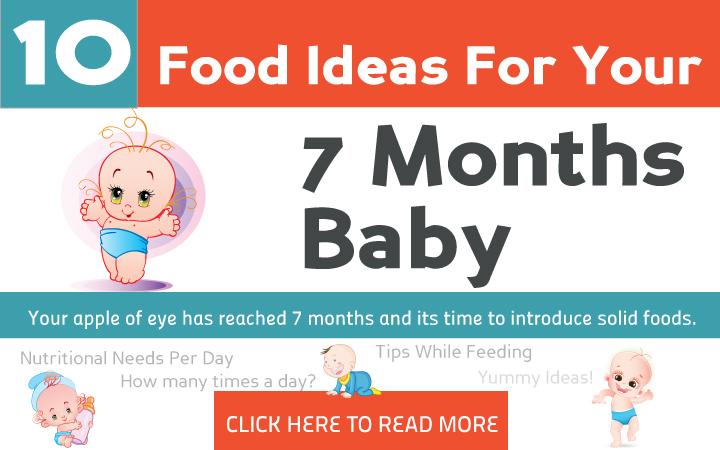
Click here to view an enlarged version of this infographic.
10 Homemade Baby Food Recipes For Your Seven Months Old
You can try these simple nutrient-rich homemade recipes to introduce your child to different flavors and textures of food (5).
1. Steamed apple and pear puree
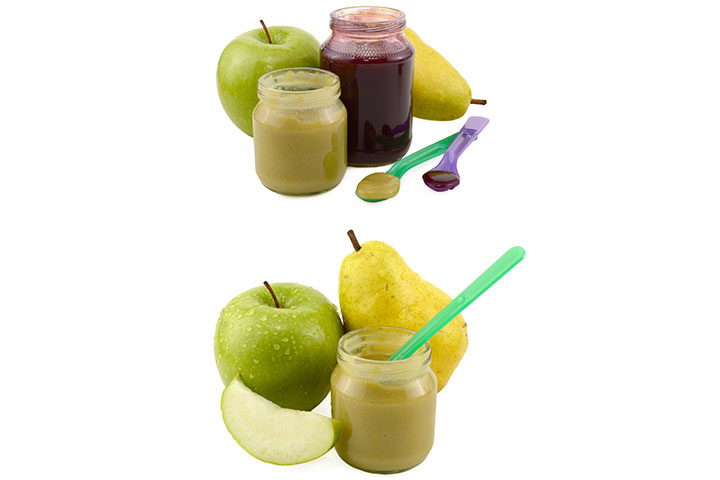
Image: Shutterstock
You will need:
- ½ apple, peeled and de-seeded
- ½ pear, peeled
How to:
- Cut the apple and pear into wedges or chunks. Put these pieces in a saucepan with water.
- Bring the water to boil and let it simmer for about 7-8 minutes. Allow it cool.
- You can make a puree and also use them as finger food (if your baby is ready to eat finger food). You can use yogurt as a dressing!
2. Eggy omelet fingers

Image: Shutterstock
You will need:
- 1 small onion, peeled and chopped
- 1 egg
- ½ teaspoon oil
How to:
- Beat the egg. Cut the onion into small pieces and add it to the egg. Whip them together.
- Put oil in a frying pan. Once the pan is hot, add the mixture and let it cook.
- Let the omelet cool. Cut it into thin slices, and serve it to the baby.
3. Hot lentil soup
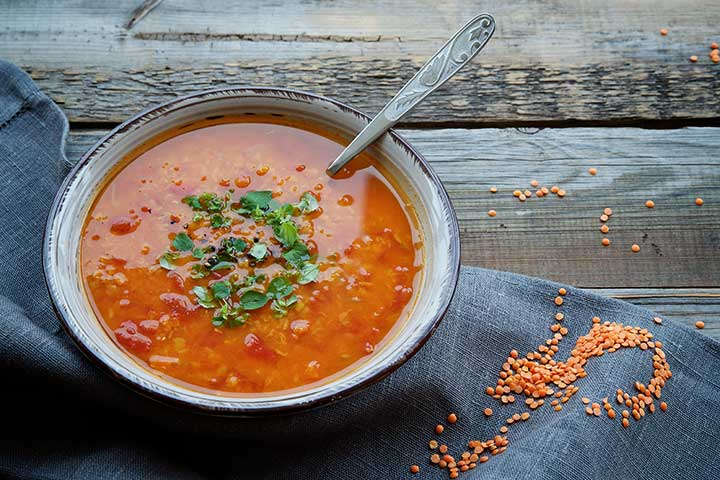

Image: Shutterstock
You will need:
- Handful of butternut squash peeled
- ¼ onion peeled and chopped
- 30 g red lentils
- ½ tsp oil
- Water
How to:
- De-seed and cut butternut squash into pieces. Finely chop the onions.
- Heat oil in a frying pan. Add all diced vegetables and let them soften.
- Then add water and washed/cleaned lentils to the pan. Bring the water to boil and let it simmer for about 20-25 minutes.
- Check if vegetables and lentils have cooked. Once cooked, let the mixture cool down and blend it before serving.
4. Berry porridge
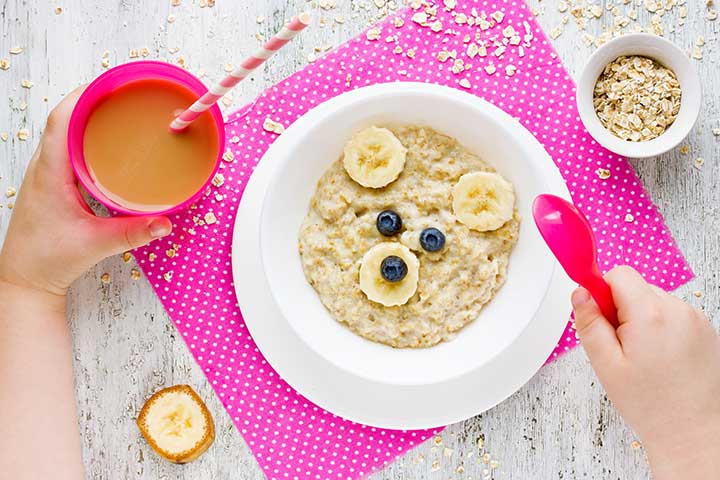
Image: Shutterstock
You will need:
- 2 tablespoon porridge oats
- ¼ banana
- Frozen blueberries (you can use fresh blueberries too)
- 1 tablespoon yogurt
- Water
How to:
- Add oats and water in a saucepan. Let it cook till the mixture thickens and softens.
- Add small pieces or mashed bananas and blueberries as a topping before serving.
5. Tangy chicken fingers
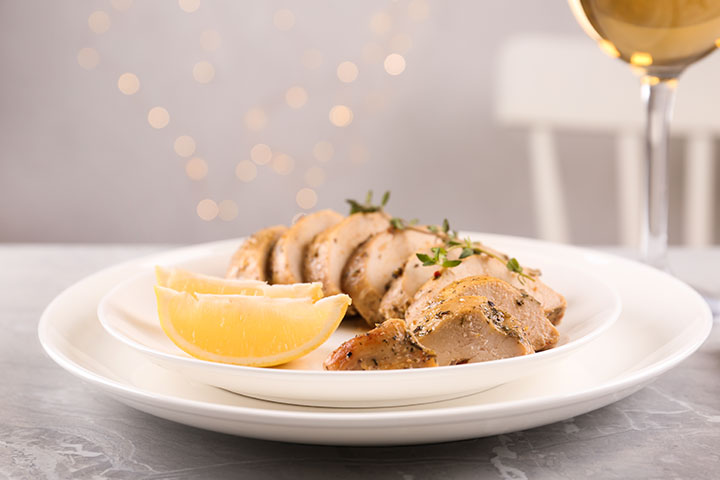
Image: Shutterstock
You will need:
- Skinless chicken breast
- ½ lemon juice
How to:
- Take skinless chicken breast and slice it into thin medium-sized pieces.
- Preheat your oven to 200°C (about 400°F).
- Place the chicken slices in a tray and squeeze a few drops of lemon juice on them.
- Bake the chicken for 25 minutes. Once baked, you can mince it or give it as finger food.
6. Veggie hotpot
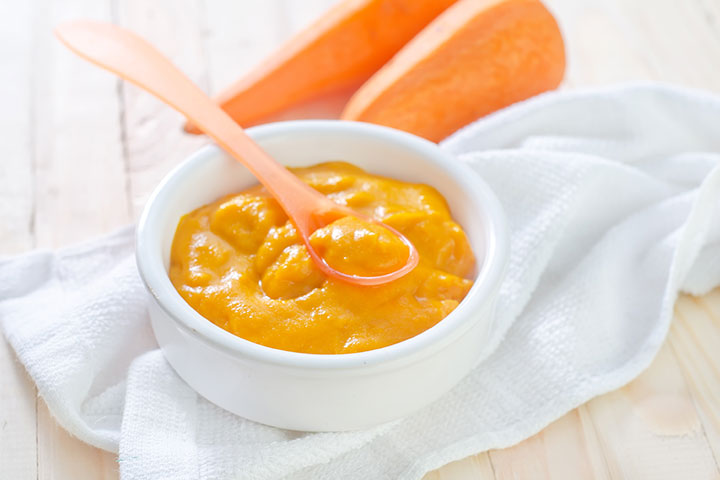
Image: Shutterstock
You will need:
- ½ leek
- ½ carrot, peeled and cut
- 1 potato, peeled and cut
- 1 tablespoon beans, chopped
- 1 small broccoli
- 1 teaspoon oil
- Water
How to:
- Peel and cut carrots and potatoes into small pieces. Cut beans and leeks.
- Take a saucepan with water and add leeks, potato, beans, and carrot. Bring it to boil and let it simmer for 15 to 20 minutes till all vegetables are cooked.
- Once cooked and cooled, blend these vegetables into a puree with pasteurized cream cheese.
- In another pan, cook pieces of broccoli in water for 3-4 minutes. Add these as finger food on top of the puree.
7. Pumpkin and thyme puree
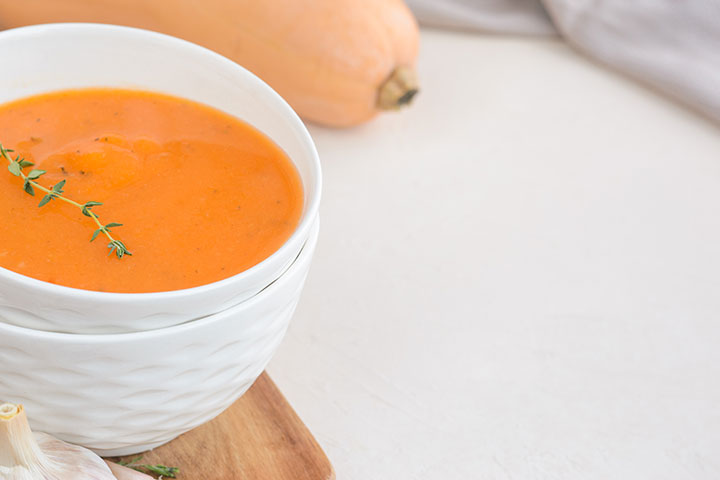
Image: Shutterstock
You will need:
- ½ pumpkin peeled and cut
- Thyme leaves
How to:
- Peel, de-seed, and chop pumpkin into small pieces. Place the pieces on a baking tray.
- Preheat oven to 175°C (about 350°F).
- Place the pumpkin and bake for 30 minutes. Once cooled, add thyme and blend it in a mixer.
8. Broccoli and spinach puree
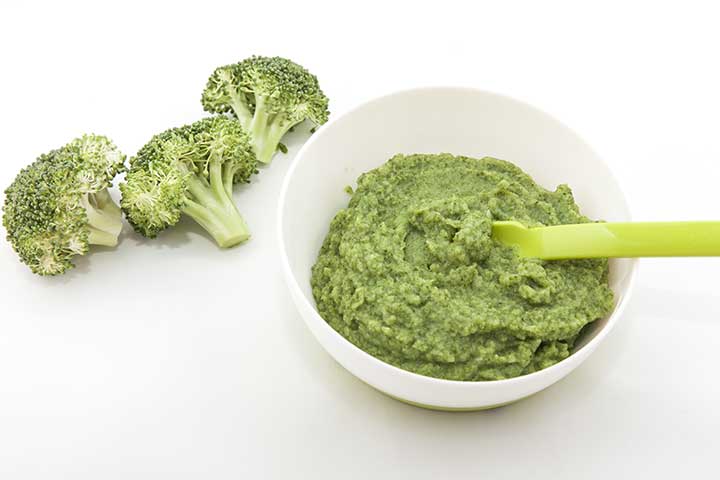
Image: Shutterstock
You will need:
- 1 medium-sized broccoli, chopped
- 5-6 spinach leaves chopped
- Water
How to:
- Bring water to boil in a pan. Add spinach leaves and broccoli florets. Let it simmer for about 10-15 minutes.
- Once cooled, mash it with a fork or blend it before serving to the baby.
9. Avocado and banana mash
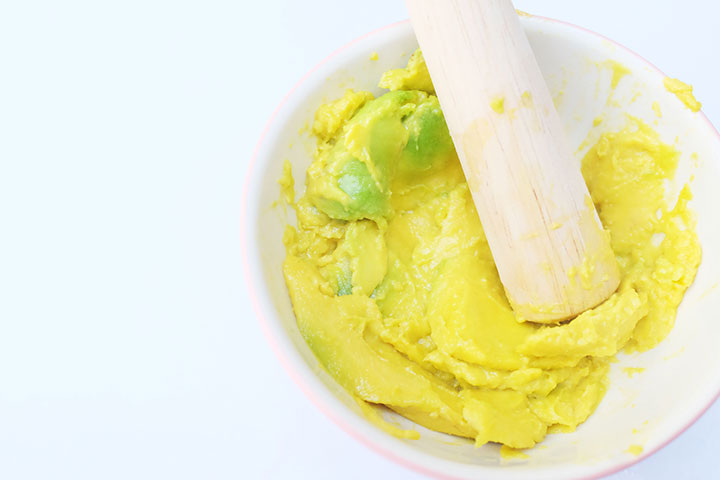
Image: Shutterstock
You will need:
- ½ avocado
- 1 banana, peeled
How to:
- Scoop out avocado and keep it in a pan. Add banana to it and mash.
- You can also add formula or breast milk to the mash and blend it before serving.
10. Root vegetables puree
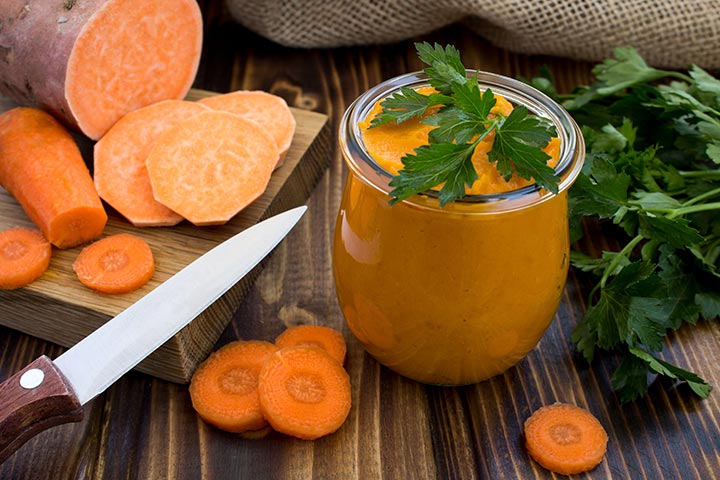
Image: Shutterstock
You will need:
- 1 carrot, peeled and chopped
- 1 sweet potato, peeled and chopped
How to:
- Place the sweet potato and carrot pieces into a saucepan with water. Bring it to boil and let it simmer for around 10-15 minutes or till the vegetables are soft.
- Let the veggies cool down and mash it with a fork or blend before serving.
Seven Months Old Baby Food Chart
You may use this sample food chart for your seven months old baby as a reference (6) (7) (8).
| Meal name | Sample meal |
|---|---|
| Breakfast (morning) | Solid food: ● Iron-fortified infant cereal Liquid: ● Breast milk or formula milk |
| Snack (late morning) | Solid food: ● Pureed or mashed fruits such as banana, kiwi, strawberries, cooked apple, cooked pear with full-fat plain yogurt (unsweetened). Liquid: · Breast milk or formula milk |
| Lunch | Solid food: ● Cooked and finely chopped chicken, ● Cooked and mashed vegetables such as pumpkin, sweet potato, spinach, squash, etc. with cooked and mashed rice. Liquid: ● Breast milk or formula milk |
| Snack (evening) | Solid food: ● Cooked and mashed pear ● Cooked and finely chopped carrots or mashed chickpeas. ● Plain yogurt ● Whole-grain cracker Liquid: ● Breast milk or formula milk |
| Dinner | Solid food: ● Cooked and finely chopped green beans or other cooked vegetables. Liquid: ● Breast milk or formula milk |
Start with one or two tablespoons of food and see if your baby shows signs of being hungry or full. Remember, their bellies are small! You can alternate between solid food and liquids, depending on your baby's hunger cues.
Try including a variety of colorful foods and textures in the baby's diet. You can also slowly start introducing finger foods by the end of seven months to develop a habit of self-feeding (6).
Seven Months Old Baby Food Schedule
According to World Health Organization (WHO), complementary foods (food items apart from breast milk) can be given to babies (six to eight months old) up to two to three times per day (9). In addition, the Centres for Disease Control and Prevention (CDC) recommends that you should give your baby something to drink or eat every two to three hours, that is, about five to six times a day (10).
Tips and Precautions For Feeding A Seven Months Old Baby
These are a few points you should consider when feeding your little one (1) (11).
- Introduce one single ingredient at a time. Give the food item for three to five days, during which do not give any other new food. Observe the baby for any sign of an allergy.
- Gradually increase the variety and quantity of food ingredients; start with a teaspoon and then move to a tablespoon.
- You can also try to give finger foods if your baby seems ready. Your baby may start to grasp items with fingers when they are ready for finger foods. Make sure you are present when your baby is eating, to avoid any choking hazards.
- Wash, peel, and remove seeds and pits before giving fruits and vegetables to your baby.
- Use a spoon to feed your baby. Make sure your baby sits in a high chair with a table when feeding.
- Observe and respond to your baby's hunger cues. Try to develop a predictable routine of all meals and snacks for your baby and limit the time of each meal from 15 to 20 minutes.
- Avoid added salt, sugar, and butter when making baby food at home. In addition, avoid cow's milk and honey until your baby is at least 12 months old.
How to Know When a Baby Is Ready for Solid Food?
According to the American Academy of Pediatrics (AAP), the following points could indicate that the baby is ready for solid food (3).
- Has good head control.
- Can sit upright in a high chair or a feeding seat (with no or little support).
- Tries to reach out (leans forward) for solid food.
- Opens mouth and seems eager to eat solid food when offered.
- Their fingers are able to grasp items, this is a sign that they are ready for solid/ finger foods.
UNICEF states that if you delay introducing solid food for too long, the baby may not gain weight at a healthy rate (12). Therefore, continue breastfeeding or formula feeding while also introducing solid food to the baby.
It can be initially a bit difficult to make your baby try different types of solid food. . Babies may even eat less on some days. Do not force-feed the baby in such situations, and let the baby eat as much they can. However, if the baby's diet is consistently low, and affects the height and weight gain, then seek advice from your healthcare provider.
What interesting and nutritious recipes have you tried for your baby? What tricks did you follow to familiarise your baby with different food flavors and textures? Share your first-hand experiences in the comment section below.
References:
MomJunction's articles are written after analyzing the research works of expert authors and institutions. Our references consist of resources established by authorities in their respective fields. You can learn more about the authenticity of the information we present in our editorial policy.
The following two tabs change content below.
- Reviewer
- Author

Charmaine Dominguez is a plant-based online dietitian nutritionist. She has her own online nutrition practice. Charmaine is currently living in LA, California in the US, and pursuing Masters of Public Health at California State University, Long Beach. She has completed her Bachelor in Nutrition and Dietetics at California State University, Long Beach. Charmaine is passionate about helping others regain control... more

Swati Patwal is a clinical nutritionist and toddler mom with over eight years of experience in diverse fields of nutrition. She started her career as a CSR project coordinator for a healthy eating and active lifestyle project catering to school children. Then she worked as a nutrition faculty and clinical nutrition coach in different organizations. Her interest in scientific writing... more
How Much Baby Food for 6 Month Old
Source: https://www.momjunction.com/articles/top-10-food-ideas-7-months-baby_006697/
0 Response to "How Much Baby Food for 6 Month Old"
Post a Comment